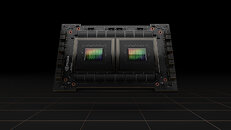
NVIDIA Launches Blackwell-Powered DGX SuperPOD for Generative AI Supercomputing at Trillion-Parameter Scale
NVIDIA today announced its next-generation AI supercomputer—the NVIDIA DGX SuperPOD powered by NVIDIA GB200 Grace Blackwell Superchips—for processing trillion-parameter models with constant uptime for superscale generative AI training and inference workloads.
Featuring a new, highly efficient, liquid-cooled rack-scale architecture, the new DGX SuperPOD is built with NVIDIA DGX GB200 systems and provides 11.5 exaflops of AI supercomputing at FP4 precision and 240 terabytes of fast memory—scaling to more with additional racks.
Featuring a new, highly efficient, liquid-cooled rack-scale architecture, the new DGX SuperPOD is built with NVIDIA DGX GB200 systems and provides 11.5 exaflops of AI supercomputing at FP4 precision and 240 terabytes of fast memory—scaling to more with additional racks.


































